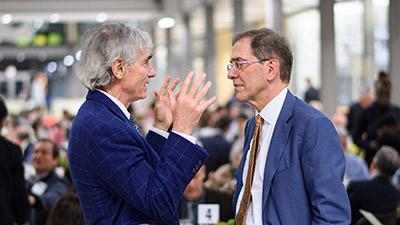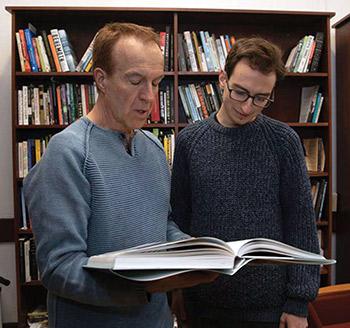
Allison Carruth, professor of the High Meadows Environmental Institute (HMEI) and the Effron Center for the Study of America, is among nearly 40 scholars formally engaged in the environmental humanities at Princeton. Photo by Barron Bixler
Princeton’s leadership in environmental studies had a seminal meeting of the minds in 1992, when President Harold T. Shapiro saw the opportunity to leverage the University’s strengths in environmental sciences and engineering. His goal was to begin positioning Princeton as a world-class center for solving the planet’s environmental challenges.
Princeton’s leadership in environmental studies had a seminal meeting of the minds in 1992, when President Harold T. Shapiro saw the opportunity to leverage the University’s strengths in environmental sciences and engineering. His goal was to begin positioning Princeton as a world-class center for solving the planet’s environmental challenges.
Author and conservationist Tom Barron, a 1974 alumnus and then-University trustee, was one of three people called in by Shapiro to discuss the possibilities. Also in the room that day were Rob Socolow, professor of mechanical and aerospace engineering, emeritus, and Henry Horn, now deceased, who was the founding director of Princeton’s Program in Environmental Studies just a year earlier.
“Harold talked about it from the practical, scientific and engineering sides,” Barron recalled. “At some point in that meeting, I raised the question, ‘Well, where in this do we get to talk about the role of the humanities?’”
Barron understood that unless researchers could communicate environmental problems to people, even the most advanced science was not going to be enough to induce action.
Shapiro assured Barron that the opportunities for humanists would be built upon the strength of Princeton’s science and engineering programs, which were more easily understood and had more straightforward access to funding. He urged some patience: “Harold said, ‘This tree that we are planting, the humanities are the higher fruits.’”
Shapiro’s promise that the environmental humanities would find their place alongside the environmental sciences and engineering has come to fruition in recent years as the fast-growing, interdisciplinary area of research and instruction has become an established strength at Princeton.
Nearly 40 scholars are formally engaged in environmental humanities through Princeton’s High Meadows Environmental Institute (HMEI), exploring questions such as how scientists and political leaders communicate environmental narratives, the ethics of when and how to take action to save the planet, and the role of artists and writers in environmental movements.
Students learn alongside these scholars and examine environmental quandaries through interdisciplinary coursework in the humanities, hands-on opportunities and seminars.

Visiting scholars join Princeton for one-year fellowships — most recently, Christina Gerhardt, founding director of Environmental Humanities at the University of Hawaii at Mānoa, who showed the impact of urban sea level rise in her riveting High Water Line: New Jersey project.
Scholars from other Princeton programs and departments, including economics, Latin American studies and music, find that their research and teaching cross disciplines in similar ways, highlighting the complexity of modern environmental questions.
The environmental humanities, defined
While the discipline is expansive, its aim is straightforward: to apply the techniques of humanistic inquiry to explore environmental concerns past, present and future. In doing so, it is telling the story of the world’s fragile environment and scientists’ efforts to save it, while also developing new ideas and potential solutions.
Environmental humanities scholars incorporate all forms of media, storytelling and creative expression, from literature and film to music and movement to data visualization. And in some regard, they all explore human interaction and interconnectedness with the environment.
“It’s a relatively new designation, but it refers to something that has been going on for a very long time,” said Rob Nixon, the Thomas A. and Currie C. Barron Family Professor in Humanities and the Environment and professor of English and HMEI. “How do we turn the abstractions of data into animated stories and images that can move people, and put faces and events and infuse drama into environmental data?”
Anne McClintock, the A. Barton Hepburn Professor in the Program of Gender and Sexuality Studies and HMEI, engages this question through a dialogue between her photographs and creative writing. Her book, “Unquiet Ghosts: From the Forever War to Climate Chaos, 1850-2022” (Duke University Press, 2023), connects three of the great crises of our time: climate change, global militarization, and the mass displacement of people and land itself.
McClintock has used her interdisciplinary lens to illuminate how the far-away melting ice caps and rising oceans, as well as the ravages of the oil companies, are displacing Native American communities in southern Louisiana — the fastest disappearing land on Earth — through her public writing and projects focusing on the Mississippi Delta and climate refugeeism.
She also launched the Fluid Futures Forum, which brings the environmental sciences and humanities into collaboration.
Ultimately, this work can make scientific data and the planetary upheavals of the Anthropocene more publicly visible and tangible to facilitate more creative strategies for change.
“The problem is not precision,” McClintock says. “The problem is perception. Our senses are not tuned to the enormity of climate change. Scientific data is certainly indispensable, but also abstract. To animate the science, we need creative stories, photographs and films, poetry and music to make the planetary upheavals of climate change imaginable, tangible and real. Only then can we envision viable strategies for action and social transformation.”
Any significant successful social movement — from abolition to suffrage to civil rights to the movement against AIDS discrimination — has been bolstered by the arts and its contributions to the larger conversation, said Nixon, whose professorship was the first named professorship in the environmental humanities at Princeton.
“All of these movements have had a strong, artistic dimension in terms of getting stories out, and using some combination of story and image as a resource for witnessing and for humanizing the concerns — for giving them an energy,” Nixon said.
Forging a path for environmental humanities
Since Barron’s early meeting with Shapiro, he and his wife, Currie Barron, have been instrumental in advancing environmental research at Princeton — and the environmental humanities, in particular — through several significant donations. Barron was influential in the launch of the Princeton Environmental Institute in 1994, which in 2020 was renamed the High Meadows Environmental Institute through a gift from the High Meadows Foundation co-founded by Judy and Carl Ferenbach III, a member of the Class of 1964.

Policy was brought into the framework of environmental research in the late 1990s and early 2000s, Barron said, opening the door for the social sciences to make more meaningful contributions to environmental discussions.
In response, he and his wife endowed the Currie C. and Thomas A. Barron Visiting Professorship in the Environment and Humanities and the Henry David Thoreau Freshman Seminar in Environmental Studies in 2007. Since then, visiting scholars in many fields — including English, religion, philosophy, political science, photography and the performing arts — have joined the Princeton faculty for a year, engaging in intensive projects and orchestrating public programs related to environmental themes.
In addition to Gerhardt, visiting scholars — who received a joint appointment in an academic department most relevant to their work — have included journalist Meera Subramanian, photographer Fazal Sheikh, playwright Steve Cossen and the late musical composer Michael Friedman. A significant outcome of the Barron Visiting Professorship was the 2018 “Nature’s Nation” exhibition curated with the Princeton University Art Museum, and led by Karl Kusserow, the John Wilmerding Curator of American Art, and 2016 Barron Visiting Professor Alan Braddock.
The couple initiated the Barron Family Fund for Innovations in Environmental Studies, which supports projects that make connections between humanities and the environment through field work and independent work by students or faculty members — including Gerhardt’s High Water Line: New Jersey — and through the development of new courses, such as Subramanian’s cross-listed journalism course on issues related to climate change and Sheikh’s visual arts course that brought students on a field trip to Bears Ears National Monument in Utah to explore the impact of climate change on the arid southwestern U.S.
The Barrons also launched a first-year seminar in environmental writing and the T.A. Barron Prize for Environmental Leadership, which HMEI confers each year during the Class Day ceremony for the Program in Environmental Studies (ENV).
Two appointed faculty in environmental humanities have been hired since 2020 — Jerry Zee, assistant professor of anthropology and HMEI, and Allison Carruth, professor of HMEI and the Effron Center for the Study of America.
But it is vision more than funding that has established and expanded the environmental humanities at Princeton, Barron said. He credits Shapiro, and the leadership of Princeton presidents Shirley M. Tilghman and Christopher L. Eisgruber, “each one reaching higher to make this all possible.”
“It was a gathering of resources, wisdom and good energy,” Barron said. “That bounty has only continued to grow.”
The undergrad experience
Through Princeton’s ENV program, undergraduates can choose from a variety of environmental courses, including multiple environmental humanities offerings, and benefit from cross-disciplinary dialogue in the classroom and the research experience of Princeton scholars.
Recent classes, projects and seminars have provided students a ground-level view of environmental issues and their potential solutions through a humanistic lens. Among them:
• Jeffrey Whetstone, professor of visual arts in the Lewis Center for the Arts and director of the Program in Visual Arts, has worked with Princeton students locally and in New Orleans to bear witness to climate change and examine the relationships between people and nature through visual media.
• An internship this summer with Carolyn Rouse, the Ritter Professor of Anthropology, and Jeffrey Himpele, director of the Ethnographic Data Visualization Lab in the Department of Anthropology, has been documenting flooding and mitigation in Princeton.
• McClintock’s interdisciplinary course “Empire of the Ark: The Animal Question in Film, Photography and Popular Culture” takes students out of the classroom into the “wilderness in their backyard” to better understand relations between humans and other species in their environments.
• Ryo Morimoto, an assistant professor of anthropology who conducted ethnographic research in Fukushima, Japan, after the 2011 nuclear disaster, teaches a course cross-listed with environmental humanities on the impact of society’s nuclear output and on manmade and nuclear catastrophes.
“Being part of this environmental humanities movement is to commit to a way of telling stories — how and who can tell stories that are both planetary, but at the same time hyperlocal,” said Morimoto, who is also the Richard Stockton Bicentennial Preceptor. “What I found through my own work on radiation exposure and irradiated environments is that the science is not enough to inform the public about how serious this is and how this happens.”
There are many other opportunities for students — as well as the larger Princeton academic community — to benefit from pioneering research and various perspectives in environmental humanities. McClintock and Nixon’s Environmental Humanities and Social Transformation Colloquium, for instance, has hosted prominent artists and scholars from around the world, building engagement among students and scholars exploring these areas.
A new body of research and knowledge
As environmental humanities have come to the fore, they also have generated original knowledge about the social, historical and ethical aspects of complex environmental challenges, from biodiversity loss to climate change.
In turn, such work — at its best — produces models of social change and methods for interdisciplinary research that are responsive to the long histories of these problems and the need for inclusive, localized, community-engaged responses, said Carruth, who joined the Princeton faculty in 2022.
Carruth said that in the present, the complex environmental challenges faced by society are as much cultural, ethical and political problems as they are scientific, technological or policy problems.
The organizing principle of her course, “Creative Ecologies: American Environmental Narrative and Art, 1980-2020,” is that the arts “are not only a place where these problems get represented or depicted imaginatively, but they actually are a place where new knowledge is generated, where possibilities for the future are articulated and tested out,” Carruth said.
In that same vein, Carruth has launched the Environmental Media Lab, an interdisciplinary center that conducts applied research and develops projects at the intersection of imagination and science. This includes a Climate Story Incubator that both produces and studies the impacts of environmental storytelling across established and emerging media.
The incubator has been examining “Coastal Futures” this summer as its inaugural project, documenting, creating, and studying multimedia stories about lived experiences of extreme weather (including storms and wildfires) and changing environmental conditions in specific coastal communities in the mid-Atlantic and California.
The overall lab also will study how — and for whom — artists, storytellers and creative communities generate knowledge about ecological crises. It plans to publish an open access journal highlighting this scholarship beginning in 2023.
Carruth said she has been thrilled to see a range of students with different majors enrolling in her courses and engaging with the lab.

The urgency of science, the introspection of literature
Jack Lohmann, Class of 2019, said he was interested in both science and the humanities while at Princeton, but never felt fully comfortable in either field. He was able to meld his passions, graduating with a degree in English and certificates in environmental studies and journalism.
His studies culminated in a senior thesis documenting life in Nauru, a Pacific island nation subjected to vast environmental degradation through decades of phosphorus mining. Lohmann expanded his research into a book that explores the role of phosphate in the origins of life, our DNA, the search for extraterrestrial life and — most urgently — a looming global food crisis as the supply of phosphate rock dwindles. The book will be published in 2024 by Pantheon.
Lohmann, whose research was supported through HMEI’s Environmental Scholars Program, credits Princeton faculty working across the environmental humanities with helping him to see the possibilities for combining his interests.
“Working with Rob [Nixon] and other professors at Princeton, I learned how to see my surroundings in a way that combined the urgency of natural science with the introspection of literature,” Lohmann said. “Everything was relevant. My job as a student was to find facts and convey them in a meaningful way. I began to sense a story of the world that was deeper and more surprising than what I had been taught before.”
For his part, Barron said he is thrilled that Princeton is producing a new generation of environmental thinkers and leaders.
“I’m particularly pleased that we are now at the stage where the highest fruit on the tree, the environmental humanities, is really, truly in our grasp,” Barron said. “It’s only when all of those strengths are involved that we can make the maximum impact as a university.”
This story originally appeared on the Princeton University website.


